Strategic HRM: IPRP's Impact on Employee Performance at Tesco
VerifiedAdded on 2023/01/07
|8
|2429
|34
Report
AI Summary
This report delves into the realm of Strategic Human Resource Management (SHRM), focusing on the efficacy of Individual Performance Related Pay (IPRP) in stimulating higher levels of employee performance, with a specific focus on its application within Tesco. The report critically evaluates the advantages and disadvantages of IPRP, exploring the circumstances under which it motivates employees and conversely, when it falls short. The analysis encompasses external and internal motivational factors, the design of reward systems, and the impact on employee retention and satisfaction. It also addresses the challenges and criticisms associated with IPRP, such as potential discrimination and the complexities of performance measurement. The report highlights the implications of IPRP on employee behavior, organizational culture, and overall business objectives. The report provides an in-depth understanding of IPRP's role in fostering a motivated workforce and achieving organizational success, while also acknowledging its limitations and potential drawbacks. This report is a valuable resource for students seeking to understand the complexities of IPRP and its impact on employee performance.

Strategic Human Resource
Management
Management
Paraphrase This Document
Need a fresh take? Get an instant paraphrase of this document with our AI Paraphraser
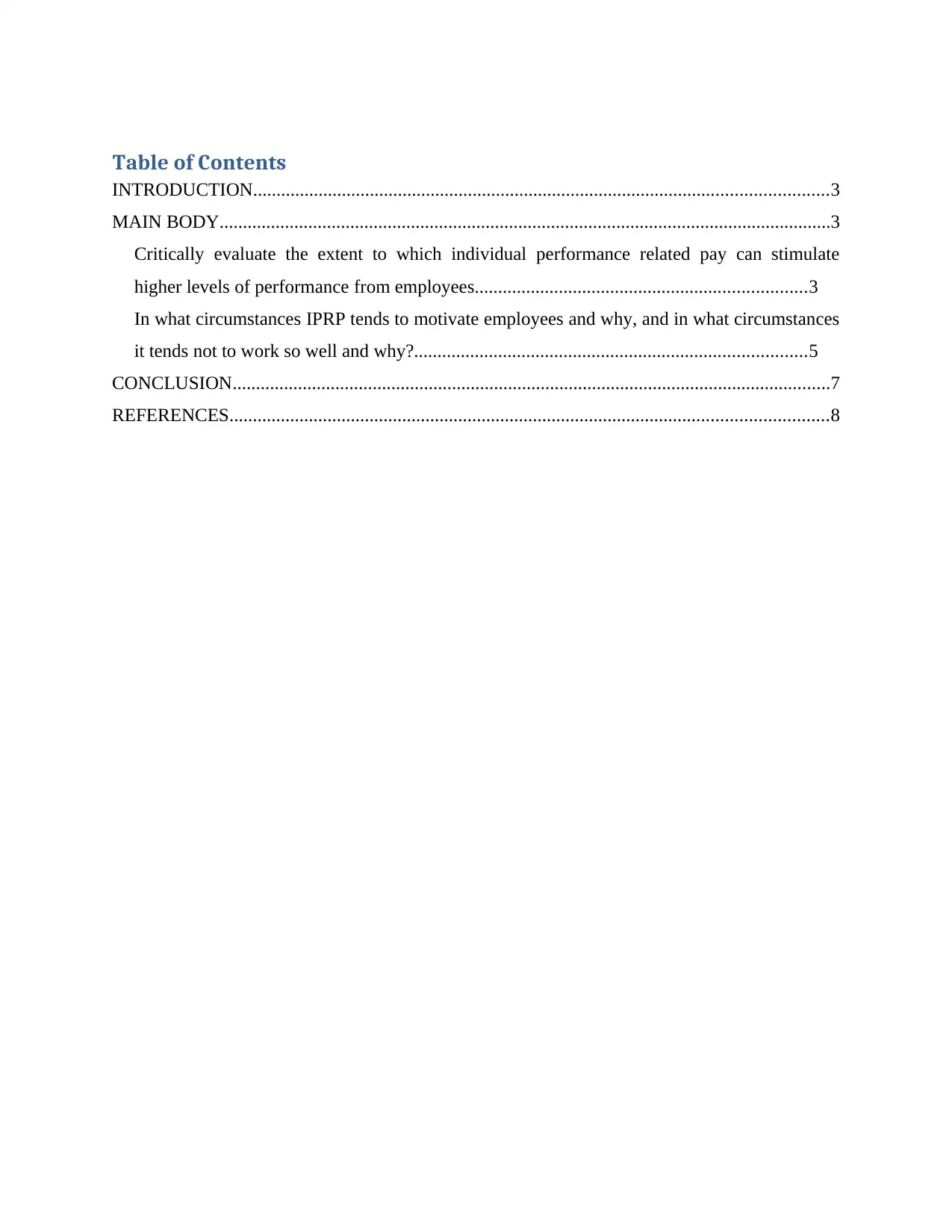
Table of Contents
INTRODUCTION...........................................................................................................................3
MAIN BODY...................................................................................................................................3
Critically evaluate the extent to which individual performance related pay can stimulate
higher levels of performance from employees.......................................................................3
In what circumstances IPRP tends to motivate employees and why, and in what circumstances
it tends not to work so well and why?....................................................................................5
CONCLUSION................................................................................................................................7
REFERENCES................................................................................................................................8
INTRODUCTION...........................................................................................................................3
MAIN BODY...................................................................................................................................3
Critically evaluate the extent to which individual performance related pay can stimulate
higher levels of performance from employees.......................................................................3
In what circumstances IPRP tends to motivate employees and why, and in what circumstances
it tends not to work so well and why?....................................................................................5
CONCLUSION................................................................................................................................7
REFERENCES................................................................................................................................8
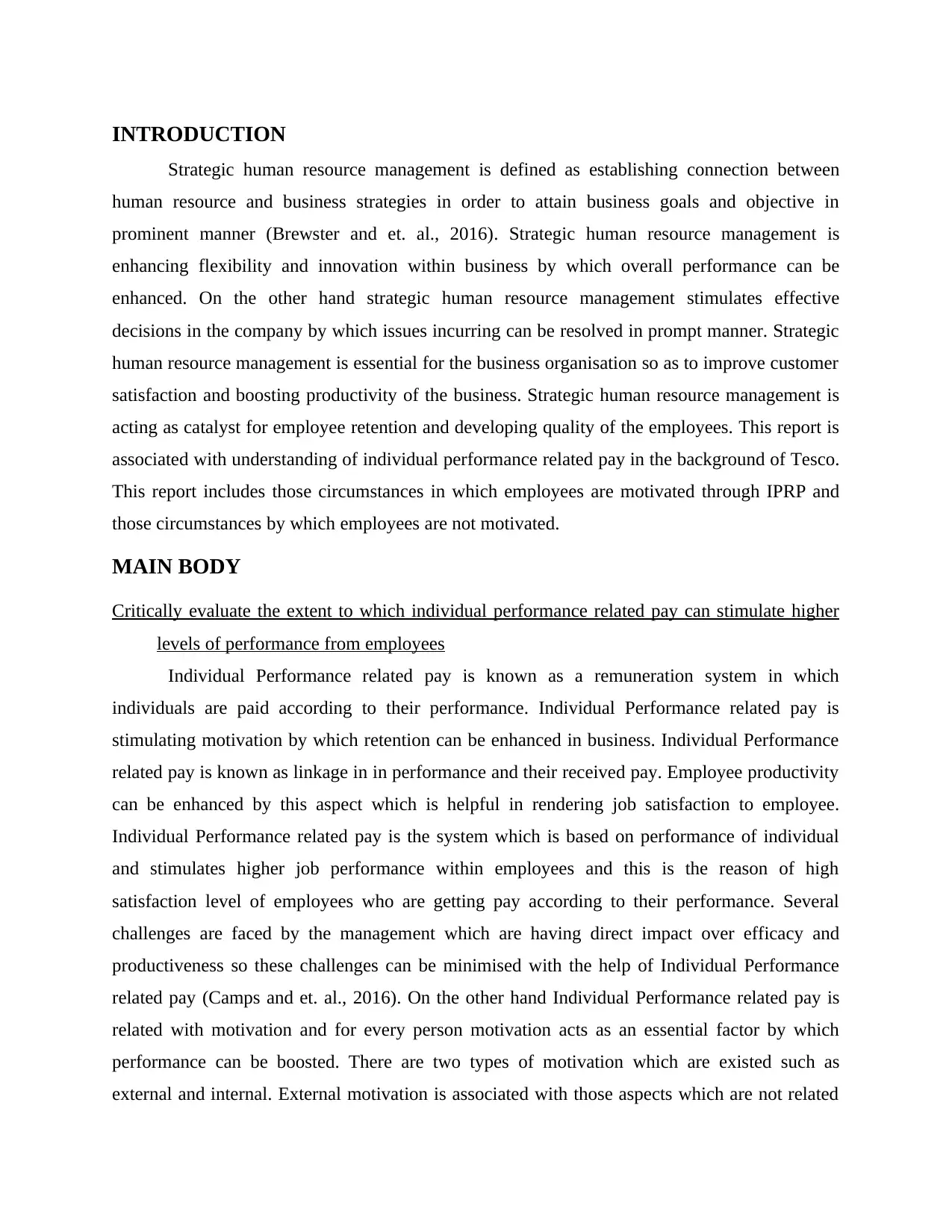
INTRODUCTION
Strategic human resource management is defined as establishing connection between
human resource and business strategies in order to attain business goals and objective in
prominent manner (Brewster and et. al., 2016). Strategic human resource management is
enhancing flexibility and innovation within business by which overall performance can be
enhanced. On the other hand strategic human resource management stimulates effective
decisions in the company by which issues incurring can be resolved in prompt manner. Strategic
human resource management is essential for the business organisation so as to improve customer
satisfaction and boosting productivity of the business. Strategic human resource management is
acting as catalyst for employee retention and developing quality of the employees. This report is
associated with understanding of individual performance related pay in the background of Tesco.
This report includes those circumstances in which employees are motivated through IPRP and
those circumstances by which employees are not motivated.
MAIN BODY
Critically evaluate the extent to which individual performance related pay can stimulate higher
levels of performance from employees
Individual Performance related pay is known as a remuneration system in which
individuals are paid according to their performance. Individual Performance related pay is
stimulating motivation by which retention can be enhanced in business. Individual Performance
related pay is known as linkage in in performance and their received pay. Employee productivity
can be enhanced by this aspect which is helpful in rendering job satisfaction to employee.
Individual Performance related pay is the system which is based on performance of individual
and stimulates higher job performance within employees and this is the reason of high
satisfaction level of employees who are getting pay according to their performance. Several
challenges are faced by the management which are having direct impact over efficacy and
productiveness so these challenges can be minimised with the help of Individual Performance
related pay (Camps and et. al., 2016). On the other hand Individual Performance related pay is
related with motivation and for every person motivation acts as an essential factor by which
performance can be boosted. There are two types of motivation which are existed such as
external and internal. External motivation is associated with those aspects which are not related
Strategic human resource management is defined as establishing connection between
human resource and business strategies in order to attain business goals and objective in
prominent manner (Brewster and et. al., 2016). Strategic human resource management is
enhancing flexibility and innovation within business by which overall performance can be
enhanced. On the other hand strategic human resource management stimulates effective
decisions in the company by which issues incurring can be resolved in prompt manner. Strategic
human resource management is essential for the business organisation so as to improve customer
satisfaction and boosting productivity of the business. Strategic human resource management is
acting as catalyst for employee retention and developing quality of the employees. This report is
associated with understanding of individual performance related pay in the background of Tesco.
This report includes those circumstances in which employees are motivated through IPRP and
those circumstances by which employees are not motivated.
MAIN BODY
Critically evaluate the extent to which individual performance related pay can stimulate higher
levels of performance from employees
Individual Performance related pay is known as a remuneration system in which
individuals are paid according to their performance. Individual Performance related pay is
stimulating motivation by which retention can be enhanced in business. Individual Performance
related pay is known as linkage in in performance and their received pay. Employee productivity
can be enhanced by this aspect which is helpful in rendering job satisfaction to employee.
Individual Performance related pay is the system which is based on performance of individual
and stimulates higher job performance within employees and this is the reason of high
satisfaction level of employees who are getting pay according to their performance. Several
challenges are faced by the management which are having direct impact over efficacy and
productiveness so these challenges can be minimised with the help of Individual Performance
related pay (Camps and et. al., 2016). On the other hand Individual Performance related pay is
related with motivation and for every person motivation acts as an essential factor by which
performance can be boosted. There are two types of motivation which are existed such as
external and internal. External motivation is associated with those aspects which are not related
⊘ This is a preview!⊘
Do you want full access?
Subscribe today to unlock all pages.

Trusted by 1+ million students worldwide
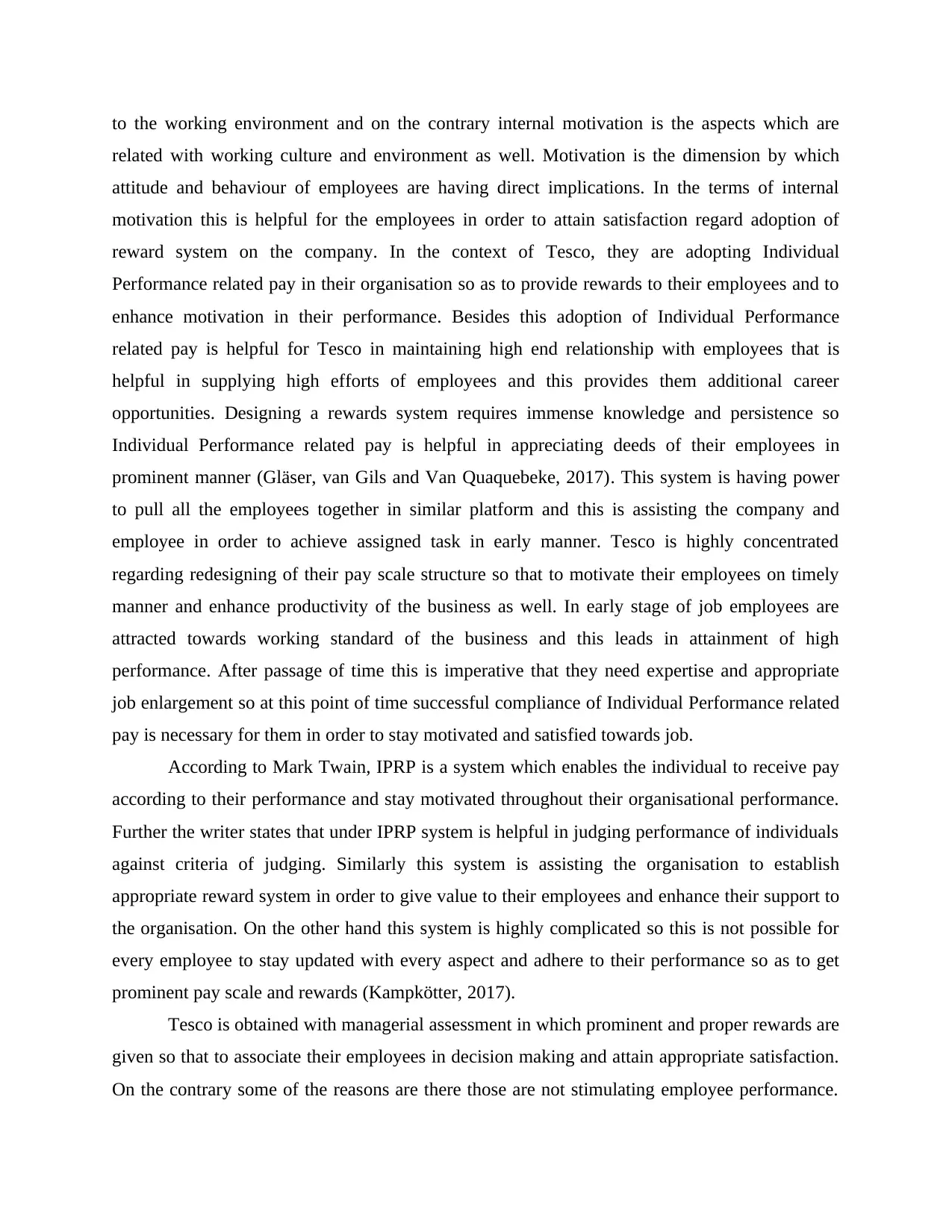
to the working environment and on the contrary internal motivation is the aspects which are
related with working culture and environment as well. Motivation is the dimension by which
attitude and behaviour of employees are having direct implications. In the terms of internal
motivation this is helpful for the employees in order to attain satisfaction regard adoption of
reward system on the company. In the context of Tesco, they are adopting Individual
Performance related pay in their organisation so as to provide rewards to their employees and to
enhance motivation in their performance. Besides this adoption of Individual Performance
related pay is helpful for Tesco in maintaining high end relationship with employees that is
helpful in supplying high efforts of employees and this provides them additional career
opportunities. Designing a rewards system requires immense knowledge and persistence so
Individual Performance related pay is helpful in appreciating deeds of their employees in
prominent manner (Gläser, van Gils and Van Quaquebeke, 2017). This system is having power
to pull all the employees together in similar platform and this is assisting the company and
employee in order to achieve assigned task in early manner. Tesco is highly concentrated
regarding redesigning of their pay scale structure so that to motivate their employees on timely
manner and enhance productivity of the business as well. In early stage of job employees are
attracted towards working standard of the business and this leads in attainment of high
performance. After passage of time this is imperative that they need expertise and appropriate
job enlargement so at this point of time successful compliance of Individual Performance related
pay is necessary for them in order to stay motivated and satisfied towards job.
According to Mark Twain, IPRP is a system which enables the individual to receive pay
according to their performance and stay motivated throughout their organisational performance.
Further the writer states that under IPRP system is helpful in judging performance of individuals
against criteria of judging. Similarly this system is assisting the organisation to establish
appropriate reward system in order to give value to their employees and enhance their support to
the organisation. On the other hand this system is highly complicated so this is not possible for
every employee to stay updated with every aspect and adhere to their performance so as to get
prominent pay scale and rewards (Kampkötter, 2017).
Tesco is obtained with managerial assessment in which prominent and proper rewards are
given so that to associate their employees in decision making and attain appropriate satisfaction.
On the contrary some of the reasons are there those are not stimulating employee performance.
related with working culture and environment as well. Motivation is the dimension by which
attitude and behaviour of employees are having direct implications. In the terms of internal
motivation this is helpful for the employees in order to attain satisfaction regard adoption of
reward system on the company. In the context of Tesco, they are adopting Individual
Performance related pay in their organisation so as to provide rewards to their employees and to
enhance motivation in their performance. Besides this adoption of Individual Performance
related pay is helpful for Tesco in maintaining high end relationship with employees that is
helpful in supplying high efforts of employees and this provides them additional career
opportunities. Designing a rewards system requires immense knowledge and persistence so
Individual Performance related pay is helpful in appreciating deeds of their employees in
prominent manner (Gläser, van Gils and Van Quaquebeke, 2017). This system is having power
to pull all the employees together in similar platform and this is assisting the company and
employee in order to achieve assigned task in early manner. Tesco is highly concentrated
regarding redesigning of their pay scale structure so that to motivate their employees on timely
manner and enhance productivity of the business as well. In early stage of job employees are
attracted towards working standard of the business and this leads in attainment of high
performance. After passage of time this is imperative that they need expertise and appropriate
job enlargement so at this point of time successful compliance of Individual Performance related
pay is necessary for them in order to stay motivated and satisfied towards job.
According to Mark Twain, IPRP is a system which enables the individual to receive pay
according to their performance and stay motivated throughout their organisational performance.
Further the writer states that under IPRP system is helpful in judging performance of individuals
against criteria of judging. Similarly this system is assisting the organisation to establish
appropriate reward system in order to give value to their employees and enhance their support to
the organisation. On the other hand this system is highly complicated so this is not possible for
every employee to stay updated with every aspect and adhere to their performance so as to get
prominent pay scale and rewards (Kampkötter, 2017).
Tesco is obtained with managerial assessment in which prominent and proper rewards are
given so that to associate their employees in decision making and attain appropriate satisfaction.
On the contrary some of the reasons are there those are not stimulating employee performance.
Paraphrase This Document
Need a fresh take? Get an instant paraphrase of this document with our AI Paraphraser
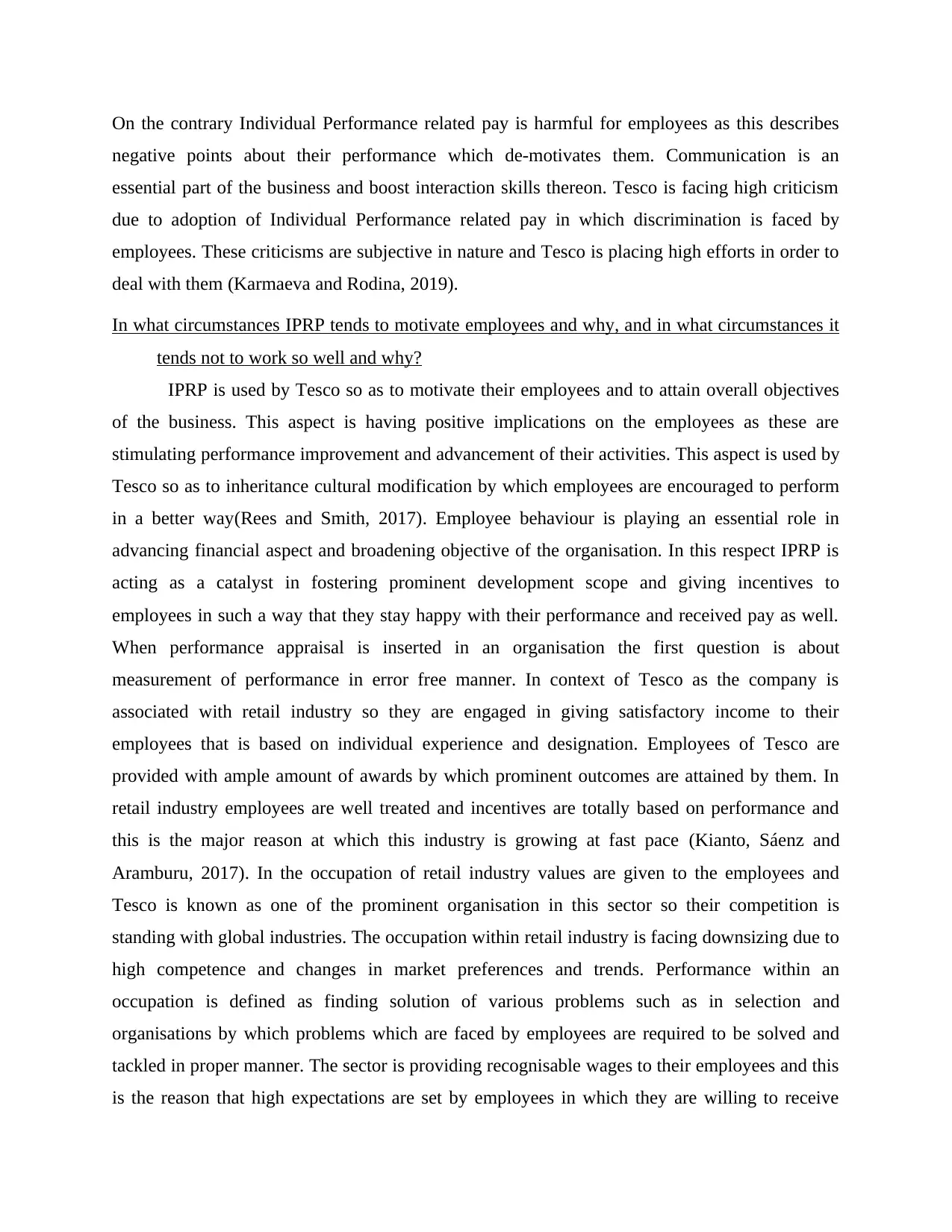
On the contrary Individual Performance related pay is harmful for employees as this describes
negative points about their performance which de-motivates them. Communication is an
essential part of the business and boost interaction skills thereon. Tesco is facing high criticism
due to adoption of Individual Performance related pay in which discrimination is faced by
employees. These criticisms are subjective in nature and Tesco is placing high efforts in order to
deal with them (Karmaeva and Rodina, 2019).
In what circumstances IPRP tends to motivate employees and why, and in what circumstances it
tends not to work so well and why?
IPRP is used by Tesco so as to motivate their employees and to attain overall objectives
of the business. This aspect is having positive implications on the employees as these are
stimulating performance improvement and advancement of their activities. This aspect is used by
Tesco so as to inheritance cultural modification by which employees are encouraged to perform
in a better way(Rees and Smith, 2017). Employee behaviour is playing an essential role in
advancing financial aspect and broadening objective of the organisation. In this respect IPRP is
acting as a catalyst in fostering prominent development scope and giving incentives to
employees in such a way that they stay happy with their performance and received pay as well.
When performance appraisal is inserted in an organisation the first question is about
measurement of performance in error free manner. In context of Tesco as the company is
associated with retail industry so they are engaged in giving satisfactory income to their
employees that is based on individual experience and designation. Employees of Tesco are
provided with ample amount of awards by which prominent outcomes are attained by them. In
retail industry employees are well treated and incentives are totally based on performance and
this is the major reason at which this industry is growing at fast pace (Kianto, Sáenz and
Aramburu, 2017). In the occupation of retail industry values are given to the employees and
Tesco is known as one of the prominent organisation in this sector so their competition is
standing with global industries. The occupation within retail industry is facing downsizing due to
high competence and changes in market preferences and trends. Performance within an
occupation is defined as finding solution of various problems such as in selection and
organisations by which problems which are faced by employees are required to be solved and
tackled in proper manner. The sector is providing recognisable wages to their employees and this
is the reason that high expectations are set by employees in which they are willing to receive
negative points about their performance which de-motivates them. Communication is an
essential part of the business and boost interaction skills thereon. Tesco is facing high criticism
due to adoption of Individual Performance related pay in which discrimination is faced by
employees. These criticisms are subjective in nature and Tesco is placing high efforts in order to
deal with them (Karmaeva and Rodina, 2019).
In what circumstances IPRP tends to motivate employees and why, and in what circumstances it
tends not to work so well and why?
IPRP is used by Tesco so as to motivate their employees and to attain overall objectives
of the business. This aspect is having positive implications on the employees as these are
stimulating performance improvement and advancement of their activities. This aspect is used by
Tesco so as to inheritance cultural modification by which employees are encouraged to perform
in a better way(Rees and Smith, 2017). Employee behaviour is playing an essential role in
advancing financial aspect and broadening objective of the organisation. In this respect IPRP is
acting as a catalyst in fostering prominent development scope and giving incentives to
employees in such a way that they stay happy with their performance and received pay as well.
When performance appraisal is inserted in an organisation the first question is about
measurement of performance in error free manner. In context of Tesco as the company is
associated with retail industry so they are engaged in giving satisfactory income to their
employees that is based on individual experience and designation. Employees of Tesco are
provided with ample amount of awards by which prominent outcomes are attained by them. In
retail industry employees are well treated and incentives are totally based on performance and
this is the major reason at which this industry is growing at fast pace (Kianto, Sáenz and
Aramburu, 2017). In the occupation of retail industry values are given to the employees and
Tesco is known as one of the prominent organisation in this sector so their competition is
standing with global industries. The occupation within retail industry is facing downsizing due to
high competence and changes in market preferences and trends. Performance within an
occupation is defined as finding solution of various problems such as in selection and
organisations by which problems which are faced by employees are required to be solved and
tackled in proper manner. The sector is providing recognisable wages to their employees and this
is the reason that high expectations are set by employees in which they are willing to receive
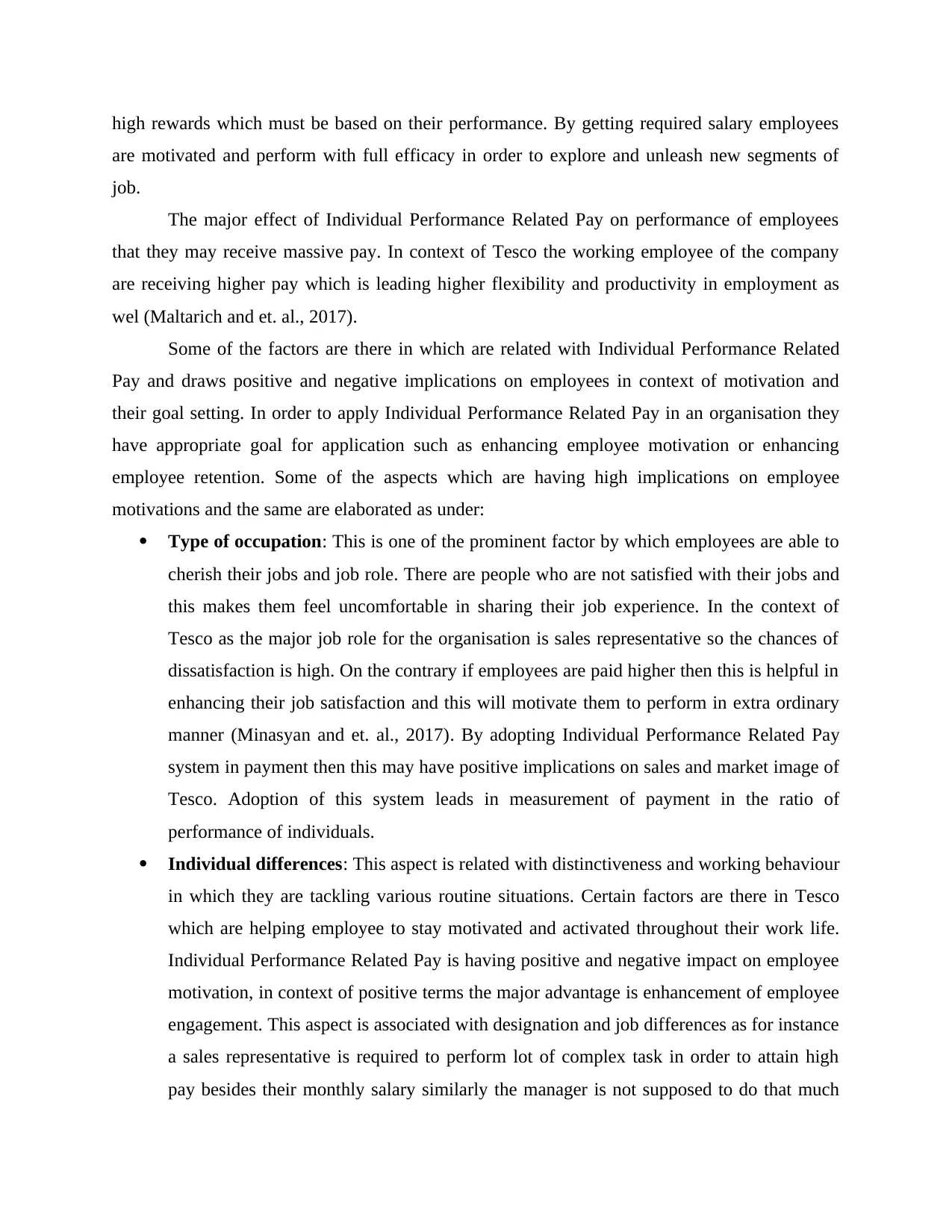
high rewards which must be based on their performance. By getting required salary employees
are motivated and perform with full efficacy in order to explore and unleash new segments of
job.
The major effect of Individual Performance Related Pay on performance of employees
that they may receive massive pay. In context of Tesco the working employee of the company
are receiving higher pay which is leading higher flexibility and productivity in employment as
wel (Maltarich and et. al., 2017).
Some of the factors are there in which are related with Individual Performance Related
Pay and draws positive and negative implications on employees in context of motivation and
their goal setting. In order to apply Individual Performance Related Pay in an organisation they
have appropriate goal for application such as enhancing employee motivation or enhancing
employee retention. Some of the aspects which are having high implications on employee
motivations and the same are elaborated as under:
Type of occupation: This is one of the prominent factor by which employees are able to
cherish their jobs and job role. There are people who are not satisfied with their jobs and
this makes them feel uncomfortable in sharing their job experience. In the context of
Tesco as the major job role for the organisation is sales representative so the chances of
dissatisfaction is high. On the contrary if employees are paid higher then this is helpful in
enhancing their job satisfaction and this will motivate them to perform in extra ordinary
manner (Minasyan and et. al., 2017). By adopting Individual Performance Related Pay
system in payment then this may have positive implications on sales and market image of
Tesco. Adoption of this system leads in measurement of payment in the ratio of
performance of individuals.
Individual differences: This aspect is related with distinctiveness and working behaviour
in which they are tackling various routine situations. Certain factors are there in Tesco
which are helping employee to stay motivated and activated throughout their work life.
Individual Performance Related Pay is having positive and negative impact on employee
motivation, in context of positive terms the major advantage is enhancement of employee
engagement. This aspect is associated with designation and job differences as for instance
a sales representative is required to perform lot of complex task in order to attain high
pay besides their monthly salary similarly the manager is not supposed to do that much
are motivated and perform with full efficacy in order to explore and unleash new segments of
job.
The major effect of Individual Performance Related Pay on performance of employees
that they may receive massive pay. In context of Tesco the working employee of the company
are receiving higher pay which is leading higher flexibility and productivity in employment as
wel (Maltarich and et. al., 2017).
Some of the factors are there in which are related with Individual Performance Related
Pay and draws positive and negative implications on employees in context of motivation and
their goal setting. In order to apply Individual Performance Related Pay in an organisation they
have appropriate goal for application such as enhancing employee motivation or enhancing
employee retention. Some of the aspects which are having high implications on employee
motivations and the same are elaborated as under:
Type of occupation: This is one of the prominent factor by which employees are able to
cherish their jobs and job role. There are people who are not satisfied with their jobs and
this makes them feel uncomfortable in sharing their job experience. In the context of
Tesco as the major job role for the organisation is sales representative so the chances of
dissatisfaction is high. On the contrary if employees are paid higher then this is helpful in
enhancing their job satisfaction and this will motivate them to perform in extra ordinary
manner (Minasyan and et. al., 2017). By adopting Individual Performance Related Pay
system in payment then this may have positive implications on sales and market image of
Tesco. Adoption of this system leads in measurement of payment in the ratio of
performance of individuals.
Individual differences: This aspect is related with distinctiveness and working behaviour
in which they are tackling various routine situations. Certain factors are there in Tesco
which are helping employee to stay motivated and activated throughout their work life.
Individual Performance Related Pay is having positive and negative impact on employee
motivation, in context of positive terms the major advantage is enhancement of employee
engagement. This aspect is associated with designation and job differences as for instance
a sales representative is required to perform lot of complex task in order to attain high
pay besides their monthly salary similarly the manager is not supposed to do that much
⊘ This is a preview!⊘
Do you want full access?
Subscribe today to unlock all pages.

Trusted by 1+ million students worldwide
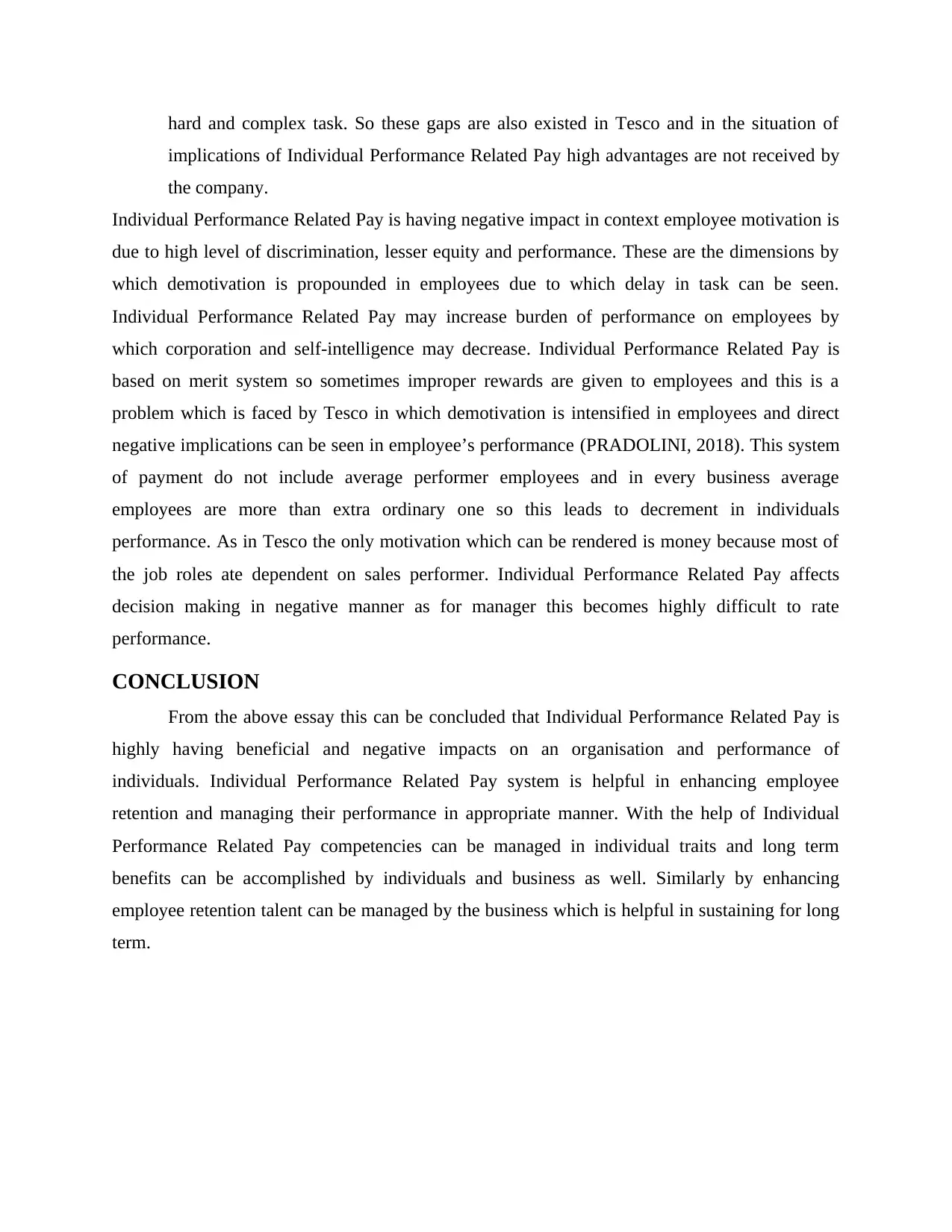
hard and complex task. So these gaps are also existed in Tesco and in the situation of
implications of Individual Performance Related Pay high advantages are not received by
the company.
Individual Performance Related Pay is having negative impact in context employee motivation is
due to high level of discrimination, lesser equity and performance. These are the dimensions by
which demotivation is propounded in employees due to which delay in task can be seen.
Individual Performance Related Pay may increase burden of performance on employees by
which corporation and self-intelligence may decrease. Individual Performance Related Pay is
based on merit system so sometimes improper rewards are given to employees and this is a
problem which is faced by Tesco in which demotivation is intensified in employees and direct
negative implications can be seen in employee’s performance (PRADOLINI, 2018). This system
of payment do not include average performer employees and in every business average
employees are more than extra ordinary one so this leads to decrement in individuals
performance. As in Tesco the only motivation which can be rendered is money because most of
the job roles ate dependent on sales performer. Individual Performance Related Pay affects
decision making in negative manner as for manager this becomes highly difficult to rate
performance.
CONCLUSION
From the above essay this can be concluded that Individual Performance Related Pay is
highly having beneficial and negative impacts on an organisation and performance of
individuals. Individual Performance Related Pay system is helpful in enhancing employee
retention and managing their performance in appropriate manner. With the help of Individual
Performance Related Pay competencies can be managed in individual traits and long term
benefits can be accomplished by individuals and business as well. Similarly by enhancing
employee retention talent can be managed by the business which is helpful in sustaining for long
term.
implications of Individual Performance Related Pay high advantages are not received by
the company.
Individual Performance Related Pay is having negative impact in context employee motivation is
due to high level of discrimination, lesser equity and performance. These are the dimensions by
which demotivation is propounded in employees due to which delay in task can be seen.
Individual Performance Related Pay may increase burden of performance on employees by
which corporation and self-intelligence may decrease. Individual Performance Related Pay is
based on merit system so sometimes improper rewards are given to employees and this is a
problem which is faced by Tesco in which demotivation is intensified in employees and direct
negative implications can be seen in employee’s performance (PRADOLINI, 2018). This system
of payment do not include average performer employees and in every business average
employees are more than extra ordinary one so this leads to decrement in individuals
performance. As in Tesco the only motivation which can be rendered is money because most of
the job roles ate dependent on sales performer. Individual Performance Related Pay affects
decision making in negative manner as for manager this becomes highly difficult to rate
performance.
CONCLUSION
From the above essay this can be concluded that Individual Performance Related Pay is
highly having beneficial and negative impacts on an organisation and performance of
individuals. Individual Performance Related Pay system is helpful in enhancing employee
retention and managing their performance in appropriate manner. With the help of Individual
Performance Related Pay competencies can be managed in individual traits and long term
benefits can be accomplished by individuals and business as well. Similarly by enhancing
employee retention talent can be managed by the business which is helpful in sustaining for long
term.
Paraphrase This Document
Need a fresh take? Get an instant paraphrase of this document with our AI Paraphraser
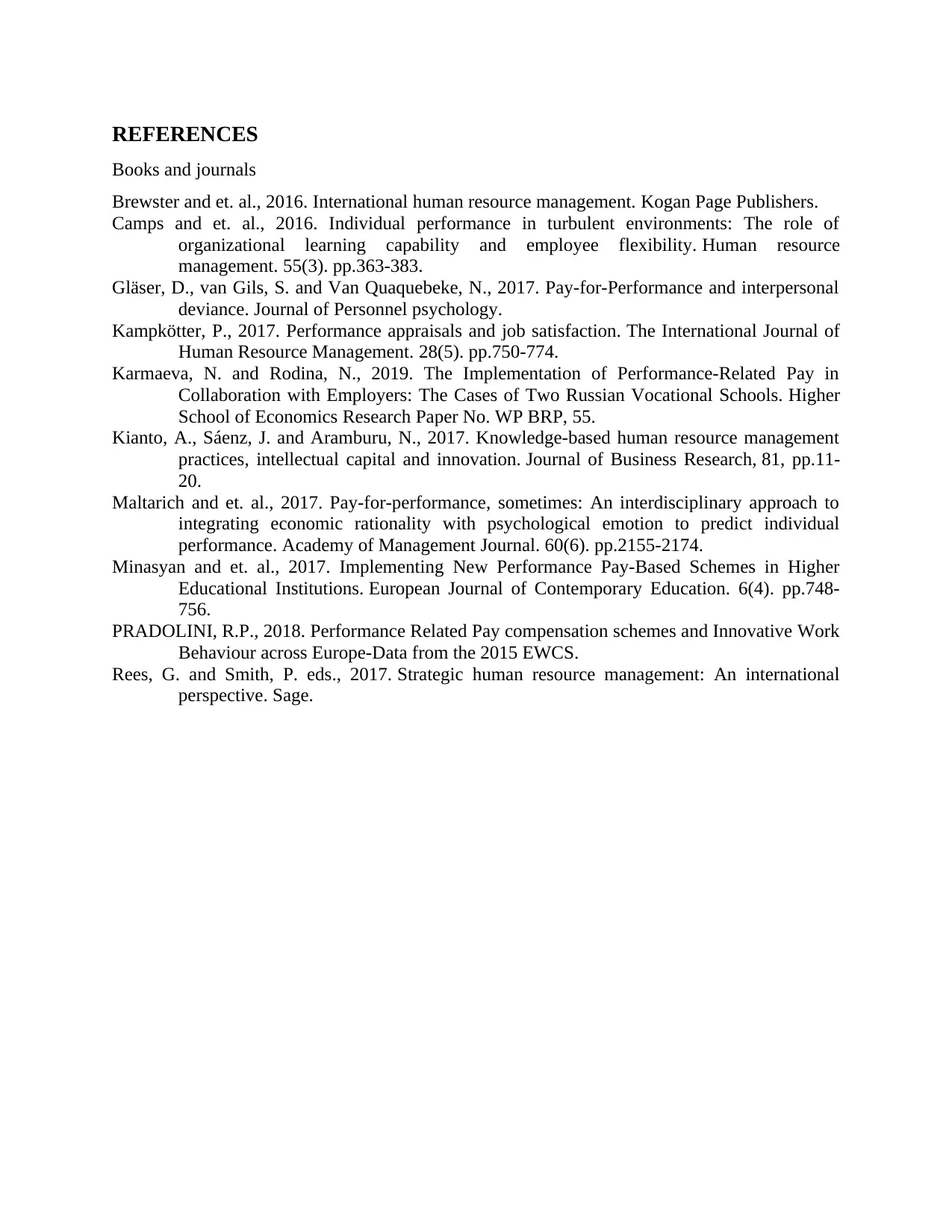
REFERENCES
Books and journals
Brewster and et. al., 2016. International human resource management. Kogan Page Publishers.
Camps and et. al., 2016. Individual performance in turbulent environments: The role of
organizational learning capability and employee flexibility. Human resource
management. 55(3). pp.363-383.
Gläser, D., van Gils, S. and Van Quaquebeke, N., 2017. Pay-for-Performance and interpersonal
deviance. Journal of Personnel psychology.
Kampkötter, P., 2017. Performance appraisals and job satisfaction. The International Journal of
Human Resource Management. 28(5). pp.750-774.
Karmaeva, N. and Rodina, N., 2019. The Implementation of Performance-Related Pay in
Collaboration with Employers: The Cases of Two Russian Vocational Schools. Higher
School of Economics Research Paper No. WP BRP, 55.
Kianto, A., Sáenz, J. and Aramburu, N., 2017. Knowledge-based human resource management
practices, intellectual capital and innovation. Journal of Business Research, 81, pp.11-
20.
Maltarich and et. al., 2017. Pay-for-performance, sometimes: An interdisciplinary approach to
integrating economic rationality with psychological emotion to predict individual
performance. Academy of Management Journal. 60(6). pp.2155-2174.
Minasyan and et. al., 2017. Implementing New Performance Pay-Based Schemes in Higher
Educational Institutions. European Journal of Contemporary Education. 6(4). pp.748-
756.
PRADOLINI, R.P., 2018. Performance Related Pay compensation schemes and Innovative Work
Behaviour across Europe-Data from the 2015 EWCS.
Rees, G. and Smith, P. eds., 2017. Strategic human resource management: An international
perspective. Sage.
Books and journals
Brewster and et. al., 2016. International human resource management. Kogan Page Publishers.
Camps and et. al., 2016. Individual performance in turbulent environments: The role of
organizational learning capability and employee flexibility. Human resource
management. 55(3). pp.363-383.
Gläser, D., van Gils, S. and Van Quaquebeke, N., 2017. Pay-for-Performance and interpersonal
deviance. Journal of Personnel psychology.
Kampkötter, P., 2017. Performance appraisals and job satisfaction. The International Journal of
Human Resource Management. 28(5). pp.750-774.
Karmaeva, N. and Rodina, N., 2019. The Implementation of Performance-Related Pay in
Collaboration with Employers: The Cases of Two Russian Vocational Schools. Higher
School of Economics Research Paper No. WP BRP, 55.
Kianto, A., Sáenz, J. and Aramburu, N., 2017. Knowledge-based human resource management
practices, intellectual capital and innovation. Journal of Business Research, 81, pp.11-
20.
Maltarich and et. al., 2017. Pay-for-performance, sometimes: An interdisciplinary approach to
integrating economic rationality with psychological emotion to predict individual
performance. Academy of Management Journal. 60(6). pp.2155-2174.
Minasyan and et. al., 2017. Implementing New Performance Pay-Based Schemes in Higher
Educational Institutions. European Journal of Contemporary Education. 6(4). pp.748-
756.
PRADOLINI, R.P., 2018. Performance Related Pay compensation schemes and Innovative Work
Behaviour across Europe-Data from the 2015 EWCS.
Rees, G. and Smith, P. eds., 2017. Strategic human resource management: An international
perspective. Sage.
1 out of 8
Related Documents
Your All-in-One AI-Powered Toolkit for Academic Success.
+13062052269
info@desklib.com
Available 24*7 on WhatsApp / Email
![[object Object]](/_next/static/media/star-bottom.7253800d.svg)
Unlock your academic potential
Copyright © 2020–2025 A2Z Services. All Rights Reserved. Developed and managed by ZUCOL.




